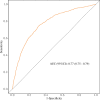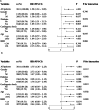The ratio of serum glucose to potassium is associated with poor prognosis in patients with severe acute myocardial infarction
- PMID: 40770037
- PMCID: PMC12329042
- DOI: 10.1038/s41598-025-14002-2
The ratio of serum glucose to potassium is associated with poor prognosis in patients with severe acute myocardial infarction
Abstract
The glucose-potassium ratio (GPR) index has been recognized as an early prognostic marker for central nervous system injuries, including aneurysmal subarachnoid hemorrhage and acute intracerebral hemorrhage. Nevertheless, its prognostic significance in critically ill patients suffering from acute myocardial infarction (AMI) who are admitted to the intensive care unit (ICU) has not been thoroughly examined. This study sought to explore the relationship between the GPR index and clinical outcomes in this group of patients. This retrospective cohort study employed data from the Medical Information Mart for Intensive Care IV (MIMIC-IV) database to identify critically ill patients with AMI who necessitated admission to the ICU. The patients were categorized into quartiles according to their GPR index levels. The primary outcomes assessed were all-cause mortality at 1 year and at 180 days. To compare survival rates across the four groups, Kaplan-Meier analysis was utilized. Additionally, Cox proportional hazards regression models and restricted cubic spline analyses were performed to investigate the association between the GPR index and clinical outcomes. The study comprised a total of 3811 patients diagnosed with acute myocardial infarction (AMI), of which 70.40% were male. Within this cohort, 999 patients, representing 26.21%, succumbed within one year. Kaplan-Meier analysis indicated a statistically significant elevation in mortality risk among patients exhibiting increased GPR indices (log-rank P < 0.001). Furthermore, restricted cubic spline analysis demonstrated a non-linear escalation in the risk of all-cause mortality corresponding to rising GPR indices (P for nonlinearity < 0.001). Multivariate Cox proportional hazards analysis revealed that individuals in the highest quartile of GPR indices faced a markedly increased risk of 1-year all-cause mortality when compared to those in the lowest quartile [HR 1.70; 95% CI (1.40-2.07); P < 0.001]. Consistent patterns were noted in the assessment of 180-day all-cause mortality. In patients with acute myocardial infarction (AMI) who are critically ill, an elevated GPR index correlates with a heightened risk of all-cause mortality at both 1 year and 180 days. These results indicate that the GPR index could be an important instrument for the identification of high-risk individuals with AMI.
© 2025. The Author(s).
Conflict of interest statement
Declarations. Competing interests: The authors declare no competing interests. Ethical approval and consent to participate: Not applicable. Consent for publication: Not applicable.
Figures





Similar articles
-
The U shape relationship between glucose and potassium ratio and mortality in patients with subarachnoid hemorrhage in the US population.Sci Rep. 2025 Jul 25;15(1):27084. doi: 10.1038/s41598-025-11630-6. Sci Rep. 2025. PMID: 40715247 Free PMC article.
-
Association between trajectory of triglyceride-glucose index and all-cause mortality in critically ill patients with atrial fibrillation: a retrospective cohort study.Cardiovasc Diabetol. 2025 Jul 10;24(1):278. doi: 10.1186/s12933-025-02838-x. Cardiovasc Diabetol. 2025. PMID: 40640797 Free PMC article.
-
Association between serum lactate and mortality in critically ill ischemic stroke patients based on MIMIC-IV data.Sci Rep. 2025 Jul 18;15(1):26155. doi: 10.1038/s41598-025-11461-5. Sci Rep. 2025. PMID: 40681728 Free PMC article.
-
[Volume and health outcomes: evidence from systematic reviews and from evaluation of Italian hospital data].Epidemiol Prev. 2013 Mar-Jun;37(2-3 Suppl 2):1-100. Epidemiol Prev. 2013. PMID: 23851286 Italian.
-
Automated monitoring compared to standard care for the early detection of sepsis in critically ill patients.Cochrane Database Syst Rev. 2018 Jun 25;6(6):CD012404. doi: 10.1002/14651858.CD012404.pub2. Cochrane Database Syst Rev. 2018. PMID: 29938790 Free PMC article.
References
-
- Virani, S. S. et al. Heart disease and stroke statistics-2020 update: A report from the American heart association. Circulation141(9), e139–e596 (2020). - PubMed
-
- Aissaoui, N. et al. Trends in cardiogenic shock complicating acute myocardial infarction. Eur. J. Heart Fail.22(4), 664–672 (2020). - PubMed
-
- Hunziker, L. et al. Twenty-year trends in the incidence and outcome of cardiogenic shock in AMIS plus registry. Circ. Cardiovasc. Interv.12(4), e007293 (2019). - PubMed
-
- Janse, M. J. & Wit, A. L. Electrophysiological mechanisms of ventricular arrhythmias resulting from myocardial ischemia and infarction. Physiol. Rev.69(4), 1049–1169 (1989). - PubMed
MeSH terms
Substances
Grants and funding
LinkOut - more resources
Full Text Sources
Medical

